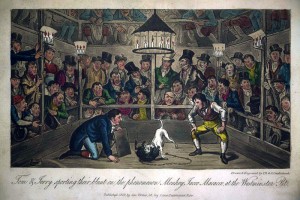DOG FIGHTING
It is important to address exactly what is dog fighting and its role in history since it is referenced frequently when discussing canine related issues. Daxton’s Friends for Canine Education & Awareness speaks openly and honestly about breeds that descend from fighting bloodlines and the potential dangers they pose to public safety. This dialogue should not be misconstrued as negative feelings towards any breed of dog. Dog fighting is extremely cruel and barbaric and is not supported or condoned. Daxton’s Friends understands that humans created these breeds for a horrific purpose and that these dogs are victims as well.
Dog fighting is considered a blood sport and consists of pitting two game dogs against one another in a ring or pit for the purpose of gambling and entertainment. The two dogs fight until one is considered the winner. The losing dog must fail to scratch, die, or jump out of the pit. Owners may call a dog fight to end it if they choose. If the losing dog survives they are typically killed by their owner.
In rural areas, dog fights are often held in barns and other indoor pits. In urban areas, dog fights are usually held in garages, basements, warehouses, alleys, or abandoned buildings.
Currently, dog fighting is illegal and a felony in all 50 United States.
The concept of dog fighting originated in Roman times. In 43 A.D., dogs fought alongside Roman and British soldiers in the Roman Conquest of Britain. The Romans preferred to use a breed from Greece called Molossus and the British used the English Mastiff, which is a descendant from the Molossus bloodline. The Romans were so impressed with the English Mastiff that they began to import them to use in the coliseum and in war. For entertainment, they would pit Mastiffs against elephants, lions, bears, bulls, and gladiators. The Romans bred and exported the Mastiff to other countries, such as France and Spain, for the same purposes. Pitting Mastiffs against bears and bulls became extremely popular in England. This ultimately contributed to decreased bear populations and they became scarce. This increased the sport’s use of bulls. In 1835, the sport was to come to an end due to the Humane Act, which outlawed baiting of any sort. The sport soon transformed into dog fighting because less space was needed and the ban was harder to enforce.
In 1817, the Staffordshire Bull Terrier was brought to the United States and dog fighting became part of the American culture. The interest in dog fighting grew tremendously after the Civil War. Many states outlawed the sport in the 1860’s due humane issues.
Over the course of history, fighting breeds changed to suit the needs of the market. When bull baiting increased in popularity, the British realized that the Mastiff was too large, heavy, and slow for combat with bulls. The dogs began to be selectively bred to have shorter legs and increased jaw strength, which led to the creation of the Old English Bull Dog. After bull baiting was outlawed and dog fighting emerged, dog fighters realized the Old English Bull Dog was not suitable to fight other dogs. They were selectively bred again with terriers to get the needed body structure, speed, aggression, and gameness of both breeds combined. Gameness is the quality of having intense eagerness, readiness, and willingness despite the threat of substantial injury. This essentially created the Staffordshire Bull Terrier. After the Staffordshire Bull Terrier arrived in America it was selectively bred again for extreme gameness, and for the absence of natural threat signals and displays, this created the American Pit Bull Terrier.
Most commonly breeds that originate from dog fighting bloodlines are known as “pit bulls”. This group of dogs is made up of several dog breeds, including the American Pit Bull Terrier, the Staffordshire Terrier, the Bull Terrier, and commonly the American Bull Dog.


Its good to see there has been some significant busts over dog fighting
It’s a gruesome story indeed, and amazing that cruelty could be thought to be so entertaining. It’s gratifying to know that well-educated populations are less likely to enjoy blood sport and more likely to pass laws against it.
I will never know what you must have experienced during the most tragic time of your lives. I really appreciate your ability to reach beyond all the intense feelings and provide an educational, rational, thorough, and helpful website addressing issues that dog owners and the public at large need to know. This article serves a great purpose because rather than vilify dogs, you recognize that they’re victims as well when cruelty and aggression are not only bred into them, but trained into them with inhuman conditions and expectations.
May I offer my heartfelt appreciation for you, what you’ve endured, and what you’ve created; and humbly pray for your continued healing, strength, and courage.
When are pitbull advocates going to stop failing to see the direct relationship between money spent on promoting pitbulls as pets on television and beyond and laws passed to make dog fighting illegal? When dog fighting was legal, there was no need for Cesar Milan or Pitbulls and Parolees. These programs to promote the OVER population of the breed did not exist as there was no need to hide dog fighting in a sea of family owned pitbulls and pitbulls clogging shelters.
Thank you.